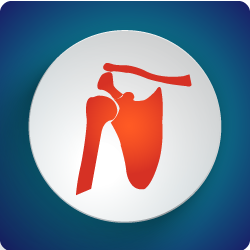
Shoulder Replacement – Conventional
Dr Chien-Wen Liew – Orthopaedic Surgeon – Adelaide, South Australia
A total shoulder replacement is used when the joint surface of the glenohumeral joint (main ball and socket joint of the shoulder) becomes worn out or injured. It is a pain relieving operation, and also generally improves range of motion of the shoulder. Shoulder replacements are less well studied than total knee replacements and total hip replacements are performed much less than hip and knee replacements. The shoulder is a unique joint in that the ball and socket are not matched in size, meaning that a lot of the stability of the shoulder comes from soft tissue structures like the labrum, and surrounding muscles (such as the shoulder rotator cuff, and deltoid).
When performing a total shoulder replacement, your surgeon will assess your shoulder to determine if you are appropriate for it. In some cases, your rotator cuff muscles are either injured, or have degenerated, and a total shoulder replacement is not suitable, as it would become unstable. In these cases, a reverse total shoulder can be used. There are specific requirements for a reverse total shoulder to be used as well, which are very important in the overall function of the shoulder.
A total shoulder replacement is performed using a muscle splitting approach. This utilises the interval between the deltoid muscle and pectorals muscle and is a standard shoulder approach. A vein runs in that interval which sometimes is damaged with minimal consequence. The muscles of the rotator cuff need to be intact for a total shoulder replacement to be successful, and it is paramount that they are not injured during the shoulder surgery.
Shoulder surgery can be more painful than hip and knee surgery, in which case a nerve block performed prior to surgery can help with the pain experienced, for a time period of 6-24 hours, depending on many factors. Typically you will spend 5 days in hospital after the operation recovering, and start exercises with physiotherapy. Your nerves will be assessed after the operation to ensure that they are working well, which is normally the case.
After the surgery, there are some movements which are restricted due to the requirement for the critical tendons to heal down. This includes the subscapularis tendon which is the most important tendon for stopping dislocations of the shoulder after surgery. You will be asked not to externally rotate your shoulder for at least 6 weeks to allow this area to heal. In the cases of a reverse total shoulder, these restrictions are not as important, as it does not rely upon the integrity of the rotator cuff to obtain its stability.
Once you have recovered from the initial surgery, you will undergo an intensive physiotherapy program to improve your range of movement and strengthen your shoulder.
For more information on shoulder surgery, please contact the office of Dr Chien-Wen Liew, Orthopaedic Surgeon. (08) 7099 0188.
Thankyou for visiting this website. Please note that the information held within this site and on this page are for educational purposes only. Please consult your doctor or health professional always prior to considering any medical therapy or intervention. If you notice an error on this site, please use our contact form to let us know so we can rectify any issues. All information and graphics on this site are the property of Sempire Designs.
